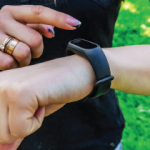 Encouraging physical activity via pedometer usage and goal setting may be a simple, low-cost approach to reducing fatigue in patients with rheumatoid arthritis (RA), say the co-investigators of a new study funded by the Rheumatology Research Foundation and recently accepted for publication in in Arthritis Care & Research.1
Encouraging physical activity via pedometer usage and goal setting may be a simple, low-cost approach to reducing fatigue in patients with rheumatoid arthritis (RA), say the co-investigators of a new study funded by the Rheumatology Research Foundation and recently accepted for publication in in Arthritis Care & Research.1
“[RA patients] suffer from fatigue, which is under-recognized and undertreated,” says Mary Margaretten, MD, associate professor of medicine at the University of California, San Francisco (UCSF) School of Medicine. “Prescribing pedometers to patients is a simple, inexpensive, effective intervention to treat fatigue in patients with RA.”
The study, “Physical Activity to Reduce Fatigue in Rheumatoid Arthritis: A Randomized, Controlled Trial,” followed 96 patients with RA in three randomized groups: a control group that included basic education on physical activity (EDUC); a group that was provided pedometers and step-tracking diaries (PED); and a group that was provided a pedometer, diary and step targets (PED+).1 Researchers monitored participant activity at the beginning and end of the study, as well as followed up with phone calls at the 10-week mark. All but eight participants completed the assessments.
The Results
According to the study, both intervention groups increased their number of steps (PED: +1,441, PED+: +1,656), and the members of the control group decreased their number of steps (-747). Self-reported fatigue decreased significantly in the PED and PED+ groups, although changes in fatigue were not significantly different between the groups. Function, self-reported disease activity and depressive symptoms did improve in the PED and PED+ groups.
“We know that even with optimal drug treatment, RA patients still have considerable levels of fatigue. There needs to be a way for them to manage fatigue outside of the normal treatment regimen,” says lead author Patti Katz, PhD, professor of medicine at UCSF School of Medicine. “We found that increasing physical activity did indeed make a difference in peoples’ fatigue level. It’s important because this is something patients can do themselves. They don’t have to go to a gym. They don’t have to spend a lot of money. They don’t have to spend a lot of time—they can go walk around the block. It makes a difference, and it doesn’t make them hurt more.”
Of course, getting patients with RA to exercise more is no easy task. Even with the low cost and advancements in technology—nearly every smartphone has a built-in pedometer—some patients may need their rheumatologist to explain the benefits and offer encouragement.
“The bottleneck may be getting this message out. People with RA sometimes do have limitations in their ability to walk. If your feet are involved, walking may not be a good option. But there are options, [such as] swimming or water aerobics programs,” Dr. Katz says. “I think there are some access issues in terms of people who have physical limitations, who don’t have access to a facility to do an alternative activity or who live in an area where they may not feel safe walking in their neighborhood. But, we also did not say you had to do all of these steps at one time. You can spread them out over the day. You don’t need any training. You don’t need supervision. You don’t have to be anywhere special to do it. Sometimes getting up to do your exercise is hard. Getting out the door is probably the biggest barrier.”
Today’s pedometers are not your grandfathers’ pedometers. They are available in a variety of shapes (clip-on, wristband, necklace, etc.), sizes and price points. They come in bright colors and with cool names, such as the Fitbit Flex, Garmin vivofit or Jawbone UPmove. The pedometers in smartphones connect to any number of user-friendly, health-tracking apps.
“I was surprised that providing pedometers alone, without guidance, was successful in increasing activity and decreasing fatigue,” Dr. Margaretten says.
Dr. Katz says she would like to expand the research to patients with systemic lupus erythematosus (SLE) and SLE patients who are depressed. She thinks, for now, pedometers and physical-activity targets should be considered a new tool for the RA patients’ treatment toolbox. Dr. Margaretten agrees and notes that rheumatologists and their RA patients currently have few inexpensive, non-drug interventions for fatigue.
“We know that physical activity is good for patients with RA and that providing pedometers is an effective strategy for reducing fatigue, depression and self-reported disease activity,” she says. “I think the next step is to implement this change (i.e., provide pedometers to patients) in real-world clinical settings and evaluate whether patients can maintain adherence outside the perfect conditions of an randomized controlled trial.”
Richard Quinn is a freelance writer in New Jersey.
Reference
- Katz P, Margaretten M, Gregorich S, et al. Physical activity to reduce fatigue in rheumatoid arthritis: a randomized, controlled trial. Arthritis Care Res (Hoboken). 2017 Apr 5. doi: 10.1002/acr.23230. [Epub ahead of print]

